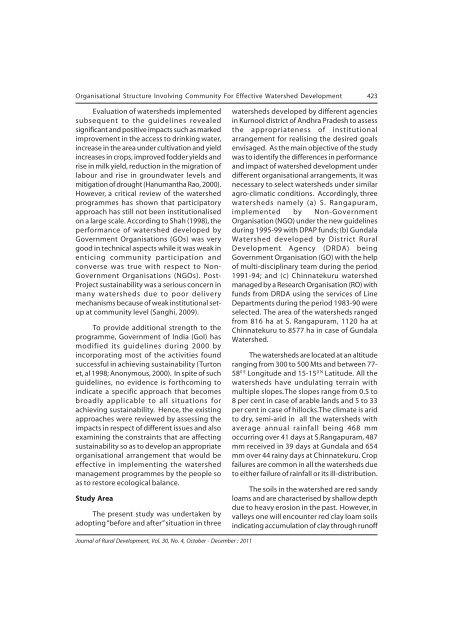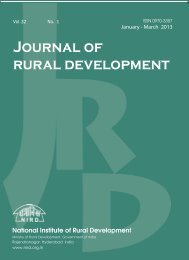Organisational Structure Involving Community For Effective Watershed Development 423Evaluation <strong>of</strong> watersheds implementedsubsequent to the guidelines revealedsignificant and positive impacts such as markedimprovement in the access to drinking water,increase in the area under cultivation and yieldincreases in crops, improved fodder yields andrise in milk yield, reduction in the migration <strong>of</strong>labour and rise in groundwater levels andmitigation <strong>of</strong> drought (Hanumantha Rao, 2000).However, a critical review <strong>of</strong> the watershedprogrammes has shown that participatoryapproach has still not been institutionalisedon a large scale. According to Shah (1998), theper<strong>for</strong>mance <strong>of</strong> watershed developed byGovernment Organisations (GOs) was verygood in technical aspects while it was weak inenticing community participation andconverse was true with respect to Non-Government Organisations (NGOs). Post-Project sustainability was a serious concern inmany watersheds due to poor deliverymechanisms because <strong>of</strong> weak institutional setupat community level (Sanghi, 2009).To provide additional strength to theprogramme, Government <strong>of</strong> India (GoI) hasmodified its guidelines during 2000 byincorporating most <strong>of</strong> the activities foundsuccessful in achieving sustainability (Turtonet, al 1998; Anonymous, 2000). In spite <strong>of</strong> suchguidelines, no evidence is <strong>for</strong>thcoming toindicate a specific approach that becomesbroadly applicable to all situations <strong>for</strong>achieving sustainability. Hence, the existingapproaches were reviewed by assessing theimpacts in respect <strong>of</strong> different issues and alsoexamining the constraints that are affectingsustainability so as to develop an appropriateorganisational arrangement that would beeffective in implementing the watershedmanagement programmes by the people soas to restore ecological balance.Study AreaThe present study was undertaken byadopting “be<strong>for</strong>e and after” situation in threewatersheds developed by different agenciesin Kurnool district <strong>of</strong> Andhra Pradesh to assessthe appropriateness <strong>of</strong> institutionalarrangement <strong>for</strong> realising the desired goalsenvisaged. As the main objective <strong>of</strong> the studywas to identify the differences in per<strong>for</strong>manceand impact <strong>of</strong> watershed development underdifferent organisational arrangements, it wasnecessary to select watersheds under similaragro-climatic conditions. Accordingly, threewatersheds namely (a) S. Rangapuram,implemented by Non-GovernmentOrganisation (NGO) under the new guidelinesduring 1995-99 with DPAP funds; (b) GundalaWatershed developed by District <strong>Rural</strong>Development Agency (DRDA) beingGovernment Organisation (GO) with the help<strong>of</strong> multi-disciplinary team during the period1991-94; and (c) Chinnatekuru watershedmanaged by a Research Organisation (RO) withfunds from DRDA using the services <strong>of</strong> LineDepartments during the period 1983-90 wereselected. The area <strong>of</strong> the watersheds rangedfrom 816 ha at S. Rangapuram, 1120 ha atChinnatekuru to 8577 ha in case <strong>of</strong> GundalaWatershed.The watersheds are located at an altituderanging from 300 to 500 Mts and between 77-58 0 E Longitude and 15-15 0 N Latitude. All thewatersheds have undulating terrain withmultiple slopes. The slopes range from 0.5 to8 per cent in case <strong>of</strong> arable lands and 5 to 33per cent in case <strong>of</strong> hillocks.The climate is aridto dry, semi-arid in all the watersheds withaverage annual rainfall being 468 mmoccurring over 41 days at S.Rangapuram, 487mm received in 39 days at Gundala and 654mm over 44 rainy days at Chinnatekuru. Cropfailures are common in all the watersheds dueto either failure <strong>of</strong> rainfall or its ill-distribution.The soils in the watershed are red sandyloams and are characterised by shallow depthdue to heavy erosion in the past. However, invalleys one will encounter red clay loam soilsindicating accumulation <strong>of</strong> clay through run<strong>of</strong>fJournal <strong>of</strong> <strong>Rural</strong> Development, Vol. 30, No. 4, <strong>October</strong> - <strong>December</strong> : <strong>2011</strong>
424 A.K. Jain, M. Gopinath Reddy and M.S. Rama Mohan Ra<strong>of</strong>rom higher slopes. The erosion intensity inthe watersheds ranged from moderate tosevere. Most <strong>of</strong> the cultivated lands <strong>of</strong> thewatersheds are classified under capabilityclass-III and class-IV while the hill areas areclassified under capability class-VI to VIII.MethodologySampling Procedure: For each watershed,50 farmers were selected representingdifferent economic strata in relation to theirproportion using stratified random samplingprocedure. The landless, marginal, small,medium and large farmers <strong>for</strong>med therespondents <strong>for</strong> the study.Nature and Sources <strong>of</strong> Data : The dataregarding the characteristics <strong>of</strong> thewatersheds, organisational structure andadministrative arrangements, cost <strong>of</strong>developmental activities, climate, land use,cropping pattern and cropping intensity andother demographic features <strong>of</strong> the study areawere collected <strong>for</strong> both the benchmark yearand years <strong>of</strong> reference (2001-2002) from theimplementing agencies. Structured scheduleswere employed to collect in<strong>for</strong>mation onplanning, implementation and problemsencountered in the implementation <strong>of</strong> thewatershed development activities from theconcerned <strong>of</strong>ficers and staff <strong>of</strong> theimplementing agencies. Apart fromstakeholders, the perceptions and responses<strong>of</strong> administrators and technocrats responsible<strong>for</strong> implementation were also obtainedthrough personal interviews after carefullyframing the issues concerning to watersheddevelopment, impact and sustainability.Details like employment generation, migrationand annual income were collected from theselected representatives <strong>of</strong> differentcategories <strong>of</strong> farmers and landless labourersthrough a structured schedule during the year2001-2002.Statistical and Analytical Tools : The data,both secondary and primary, were analysedusing appropriate statistical tools. Measures<strong>of</strong> central tendency and ratios, specificallysimple averages and percentages wereemployed to compare the data between thedifferent areas selected with respect to landuse, cropping pattern, crop yields, returns andincome.Implementation Process : The WatershedDevelopment Team (WDT) members underNGO organised S. Rangapuram watershed,interacted with Watershed Association (WA),Watershed Committee (WC), User Group (UG)and Self-Helf Group (SHGs) and otherstakeholders to assess knowledge levelspertaining to natural resources and theirmanagement. During the first phase, EntryPoint Activities were taken up to address theirimmediate problems, so as to enlist theirparticipation in the future programme. In thesecond phase, Participatory <strong>Rural</strong> Appraisal(PRA) was carried out to determine theproblems and assess opportunities <strong>for</strong>choosing appropriate techniques/strategies toovercome the same in all sectors. Theprogramme was implemented subsequentlyinvolving people as per the guidelines.In the case <strong>of</strong> Gundala watershed, theMulti-disciplinary Team working under theProject Director, DRDA had <strong>for</strong>med theWatershed Committee and an action plan wasprepared in consultation with people involvingLine Departments <strong>for</strong> conserving resourcesand improving productivity. The programmewas implemented through the LineDepartments in association with people.In the case <strong>of</strong> Chinnatekuru watershed,the scientists from Central Soil and WaterConservation Research and Training <strong>Institute</strong>(CSWCR&TI), Bellary (Karnataka) conductedinitial surveys <strong>for</strong> preparing the inventory <strong>of</strong>resources involving staff from LineDepartments under the overall supervision <strong>of</strong>DRDA. After discussing the needs andpriorities <strong>of</strong> the people by <strong>for</strong>ming a WatershedJournal <strong>of</strong> <strong>Rural</strong> Development, Vol. 30, No. 4, <strong>October</strong> - <strong>December</strong> : <strong>2011</strong>
- Page 3 and 4: Journal ofRural DevelopmentVol. 30
- Page 5 and 6: Journal of Rural Development, Vol.
- Page 7 and 8: Promoting E-Governance in Panchayat
- Page 9 and 10: Promoting E-Governance in Panchayat
- Page 11 and 12: Promoting E-Governance in Panchayat
- Page 13 and 14: Promoting E-Governance in Panchayat
- Page 15 and 16: Promoting E-Governance in Panchayat
- Page 17 and 18: Promoting E-Governance in Panchayat
- Page 19 and 20: Promoting E-Governance in Panchayat
- Page 21 and 22: Promoting E-Governance in Panchayat
- Page 23 and 24: Journal of Rural Development, Vol.
- Page 25 and 26: Climate Change and Rainfed Agricult
- Page 27 and 28: Climate Change and Rainfed Agricult
- Page 29 and 30: Climate Change and Rainfed Agricult
- Page 31 and 32: Climate Change and Rainfed Agricult
- Page 33: 422 A.K. Jain, M. Gopinath Reddy an
- Page 37 and 38: 426 A.K. Jain, M. Gopinath Reddy an
- Page 39 and 40: 428 A.K. Jain, M. Gopinath Reddy an
- Page 41 and 42: 430 A.K. Jain, M. Gopinath Reddy an
- Page 43 and 44: 432 A.K. Jain, M. Gopinath Reddy an
- Page 45 and 46: 434 S.Mohanakumar, R.VipinkumarIntr
- Page 47 and 48: 436 S.Mohanakumar, R.VipinkumarTabl
- Page 49 and 50: 438 S.Mohanakumar, R.VipinkumarTabl
- Page 51 and 52: 440 S.Mohanakumar, R.VipinkumarForm
- Page 53 and 54: 442 S.Mohanakumar, R.Vipinkumarmuch
- Page 55 and 56: 444 S.Mohanakumar, R.VipinkumarEsta
- Page 57 and 58: 446 S.Mohanakumar, R.VipinkumarTabl
- Page 59 and 60: 448 S.Mohanakumar, R.VipinkumarTabl
- Page 61 and 62: 450 S.Mohanakumar, R.VipinkumarRefe
- Page 63 and 64: 452 B.B. Malik and Jaya Shrivastava
- Page 65 and 66: 454 B.B. Malik and Jaya Shrivastava
- Page 67 and 68: 456 B.B. Malik and Jaya Shrivastava
- Page 69 and 70: 458 B.B. Malik and Jaya Shrivastava
- Page 71 and 72: Journal of Rural Development, Vol.
- Page 73 and 74: Levels of Living of Rural Household
- Page 75 and 76: Levels of Living of Rural Household
- Page 77 and 78: Levels of Living of Rural Household
- Page 79 and 80: Levels of Living of Rural Household
- Page 81 and 82: Levels of Living of Rural Household
- Page 83 and 84: Journal of Rural Development, Vol.
- Page 85 and 86:
The Pattern of the Distribution of
- Page 87 and 88:
The Pattern of the Distribution of
- Page 89 and 90:
The Pattern of the Distribution of
- Page 91 and 92:
The Pattern of the Distribution of
- Page 93 and 94:
The Pattern of the Distribution of
- Page 95 and 96:
The Pattern of the Distribution of
- Page 97 and 98:
Journal of Rural Development, Vol.
- Page 99 and 100:
Structural, Functional and Situatio
- Page 101 and 102:
Structural, Functional and Situatio
- Page 103 and 104:
Structural, Functional and Situatio
- Page 105 and 106:
Structural, Functional and Situatio
- Page 107 and 108:
Structural, Functional and Situatio
- Page 109 and 110:
Structural, Functional and Situatio
- Page 111 and 112:
502 Book ReviewsRole of Micro Finan
- Page 113 and 114:
504 Book ReviewsSardar Sarovar Proj
















